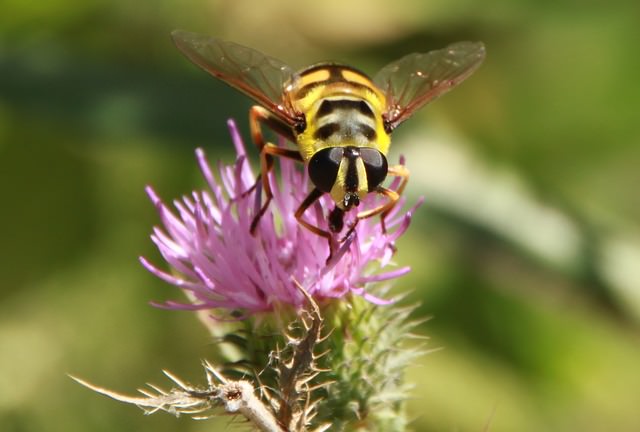Bugs are a summer bummer. Your dog thinks so too. While it’s not pleasant to think about, bugs are a natural part of the season. But the more you know about hazards to your dog’s health, the better you can act if a situation arises. Plus, you can take preventative measures so you may not have to deal with these pests in the first place! Here’s what you need to know about the bugs that cause problems for dogs, and what you can do about it.

#1 – Fleas
Fleas are important because their saliva is one of the most irritating substances on the planet. Their bites are itchy and can become infected easily if your dog scratches or bites at them. Flea allergy is very common in dogs and is a frequent diagnosis in my hospital. Fleas can survive in most climates and are very prolific. They can make a home in your house and car, hiding in cracks and crevices, even furniture. They will bite your dog and they may bite you. When I see a flea allergic pet, the owner invariably tells me that their dog does NOT have fleas. But the fact is…if you are not actively applying a prescription flea product exactly as directed, the chances are very good that your dog does indeed have fleas, even if you have never seen one. Most of the flea life cycle is not actually ON the pet, so not seeing them doesn’t mean much.
2. Ticks
Ticks are one of the most common disease vectors (insect that spread disease). There are many kinds of ticks and some are linked to significant diseases, like Lyme’s Disease, Rocky Mountain Spotted Fever and Ehrlichiosis. Fortunately not all kinds of ticks are adapted to live their life cycle indoors, like fleas can, but you still do not want them on your dog. Dogs should be on an effective veterinary recommended product throughout the season. Their bites get itchy and infected too. Check your dog for ticks twice daily since most diseases require several hours of attachment to transmit. If your dog is acting ill, lethargic and sore, be sure to mention any ticks you have found to your vet.

3. Mosquitoes
Mosquitoes are irritating and ubiquitous. Their major significance, in my opinion, is that the carry heartworm disease. I have had clients tell me that their dogs do not need heartworm prevention because they are indoor dogs, but mosquitoes do get inside (I saw one in my house in the winter last year!) and most dogs do go outside to urinate and defecate. Mosquitoes can carry other vector diseases, like West Nile virus. Protect your dog from heartworms (which are ultimately fatal if left untreated) with a prescription heartworm preventative no matter what. Some of the flea and tick products also have a mosquito claim on their labels.
4. Spiders
Spiders can bite dogs. I have seen wounds that I believed to be spider bites many times, although there is never proof. These local bites get worse when the dog licks them and often become a draining infected sore, many times on the feet. Depending on the type of spider, bites can become a bigger deal if left untreated, as the tissue around the bite can die and slough off. If your dog has a draining sore that he is licking, you need to see a vet. In the meantime, keep him from licking the area with a bandage or E-collar (Be sure that any bandage is not applied tightly).

6. Ants
Sometimes dogs walk right into ant beds and sustain multiple bites. They will look like hives and may spread over most of the body. It is common for the dog to have a marked reaction at the site of the bites, although anaphylaxis (allergic shock) from any bites is not frequently seen in dogs. These itchy bites will be very uncomfortable and pruritic. Your vet can give your dog an injection to calm the severity of the response and improve the comfort level while healing.
6. Flies
Flies are really gross and although they seem like merely a nuisance, they can cause medical problems for dogs. “Fly Strike” is a syndrome in which an area becomes scabbed and infected from the presence of flies. I usually see this problem in the heat of the summer and most often on the tips of the ears of dogs who spend lots of time outside. There are many nerves in the ears and this condition is very uncomfortable for dogs. The flies are feeding on the dog’s blood and serum that oozes from the wound and can even lay eggs in the affected area, producing maggots. If you notice wounds on your dog’s ears or face, it might be fly strike. Cleanse the area gently (if your dog can tolerate the pain) and see your vet for additional treatment.

7. Yellow Jackets
I see dogs with these types of stings all summer long. Most owners tell me that it was a bee, but it is more likely to have been a yellow jacket since they are aggressive and nest on the ground. Regardless of the exact species of stinging, flying insect, these stings are always painful and become itchy as they heal. True anaphylaxis from these can happen and I have a few patients that require medication at every exposure, but usually these are localized issues that heal without incident. If you see a stinging insect sting your dog, watch her carefully for immediate signs of respiratory distress (this is an emergency), and call your vet if the sting starts to look infected, severely swollen or oozes anything.
Bugs are the villains of summer, but you can be a hero if you follow these suggestions.
 Toledo, United States.
Toledo, United States.